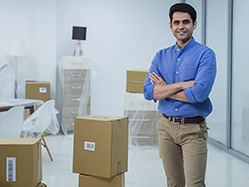Step 1: Know how much you can spend
The first step toward a safe investment for retirement is knowing how much you can afford to spend. The common approach followed—take out only 4% of your savings the first year you’re retired, and then increase this amount each following year for inflation. However, that may not be practical for all.1
You may want to think about using retirement calculators or talking with a financial consultant regarding your planning. These resources generally can give you a better understanding of whether savings will last for 25 or 30 years. If your calculations show you might run out of money soon, you can manage this risk by cutting expenses or withdrawing only the income you need. This helps your retirement funds last longer and provides a steady income despite market ups and downs.
Step 2: Look for ways to reduce your spending
Another smart step in retirement planning in a volatile market is to control spending. Start by writing down everything you spend money on. Then group them as:
- Needs: Like rent, food, medicines
- Wants: Like eating out or watching movies
- Wishes: Like going on big vacations or buying gadgets
Now, look at your wants and wishes. Can you cut back? Maybe eat out less often, or skip a holiday this year. Reducing such expenses means you won’t have to sell your investments when their value is low. Even small changes can help. Lower electricity bills, shop during sales, or cancel unused memberships. This helps you protect retirement savings from market fluctuations.
Step 3: Look for other cash solutions
If you don’t have much cash saved, try these ideas:
- Check for emergency funds: Do you have any old bank accounts with savings?
- Sell unused items: Old furniture, electronics, or extra vehicles can be sold.
- Tax refund: If you expect one, file early.
- Subscriptions: Ask for refunds on yearly plans you don’t need.
- Annuity income: If you own an annuity, you can talk to an expert to see if it’s time to start getting monthly payments.
All these steps help you get money without touching your main savings. This makes your plan more stable and helps you protect your retirement funds.
Step 4: If You Must Tap Your Savings, Be Strategic
When you need to use your savings, it’s important to be smart about how you take out money. Selling the wrong things at the wrong time can cause more loss. There are better ways to get cash without hurting your future too much. Always try to take money from safe places first. This step-by-step guide will show you how to make better choices when using your savings. With some planning, you can still keep most of your money safe while getting what you need today.
Start with interest and dividends from your taxable accounts
Start by using any money you earn from interest or dividends. This is income you get from your savings or investments, like money earned from fixed deposits or stocks. The good part is that you don’t have to sell anything—you just use what your money has made. This helps keep your main savings safe and growing. Interest from bonds or savings accounts and dividends from stocks can give you a steady cash flow. It’s a simple and safe way to get money without touching your main savings too soon.Tap the principal from maturing bonds or CDs
When bonds or certificates of deposit (CDs) mature, they return the full amount you put in—called the principal. This is a good time to use that money if needed. Since the money is coming back to you after a set time, there’s no loss. You don’t need to sell anything early or pay extra charges. This step is safe and planned. Many people use bonds and CDs in retirement because they give back money at the right time for use. It’s one of the safest ways to access funds.
Consider selling lower-volatility investments
If you still need cash, think about selling low-risk investments like short-term bonds. These don’t change in value much, even if the market is unstable. Selling these means you won’t lose much, unlike stocks, which may go up and down a lot. These safer investments are good for emergency use or short-term needs. They are usually easy to sell quickly without a big drop in value. Using them can help you avoid touching your riskier investments too early in retirement.Rebalance your portfolio
Rebalancing means checking your investments and making sure they match your plan. Sometimes, some of your investments grow faster than others. You may end up with too much in one type of investment. To fix this, you sell a bit of what has grown too much and buy what is now less. This helps you keep your plan safe and balanced. If you need cash, this is also a good way to raise money while staying on track with your goals.Remove investments you don't require
If you own something that no longer fits your needs or is not performing well, you can think about selling it. Maybe you bought a stock or fund that is now not doing as expected. Instead of holding onto it, use that money for your current needs. This is called pruning your portfolio. It helps you clean up your investments and use the cash for more useful things. It’s better to let go of what you don’t need than to risk a bigger loss later.Use investment losses to reduce your tax bill
Sometimes your investments may lose value. While this feels bad, it can still help you save money. If you sell those loss-making investments, you can use the loss to lower the tax on other profits. This is called tax-loss harvesting. You can even use the loss to lower your taxable income by up to a set limit. So, even a bad investment can help you in another way. It’s a smart idea to speak to a tax expert if you’re unsure.Make tax-efficient choices
If you need to sell investments, try to sell the ones you’ve had for more than a year. These are called long-term investments and usually get taxed at a lower rate. This helps you keep more of your money. Avoid selling investments that you just bought recently, as they may have higher taxes. Also, check if you can use any tax exemptions, like those on senior citizen savings. These small steps help you get the cash you need while keeping your tax bill low.
The bottom line
Planning for a safe investment after retirement doesn’t mean avoiding the market. It means preparing for it. You can still grow your money while keeping it safe. The idea is to make smart, small moves—reduce spending, use cash first, and sell wisely. These steps help you build secure retirement income even when the market is not steady. You don’t have to do it all alone. Ask a trusted expert or use tools that make things easier. With a few careful steps, you can enjoy retirement without fear.
FAQs
How can you protect yourself from market volatility?
To stay safe during market ups and downs, keep some money in savings accounts or fixed deposits. These are not affected by market changes. You can also use short-term bonds. Try to spend only what you need and avoid selling risky investments when prices are low. Planning ahead is very helpful. If you already know how much money you will need and where it will come from, you can stay calm even when the market goes down.
How to protect your nest egg even in volatile times?
Your "nest egg" refers to the money you are saving for retirement. The formula for protecting it is to save an extra amount of cash in safe places, such as savings accounts. You will want to use that cash first, before stocks and mutual funds. If you are looking for monthly income and want annuity payments, you can also do that. Therefore, if you are using money other than savings, then you will not have to sell stocks, mutual funds, etc. when the prices are low, thus protecting your nest egg.
What is the safest investment for retirement funds?
Savings accounts, fixed deposits, short-term bonds, government-guaranteed options, treasury bills, easy cash, etc., are some of the safest ways to keep your retirement money. Of course, these options do not provide big returns, but you are investing the money safely, giving you the opportunity or chance to earn investment risk-free returns. If you need a monthly income, you can also turn your investment funds into annuity payments. Based on certain ratings, you will receive a cheque in the mail every month, which helps to pay for your monthly expenses. Your safety is much more important to weigh than your incredible investment returns, since you are investing your own savings in retirement





























 An ISO 9001:2015
An ISO 9001:2015 

